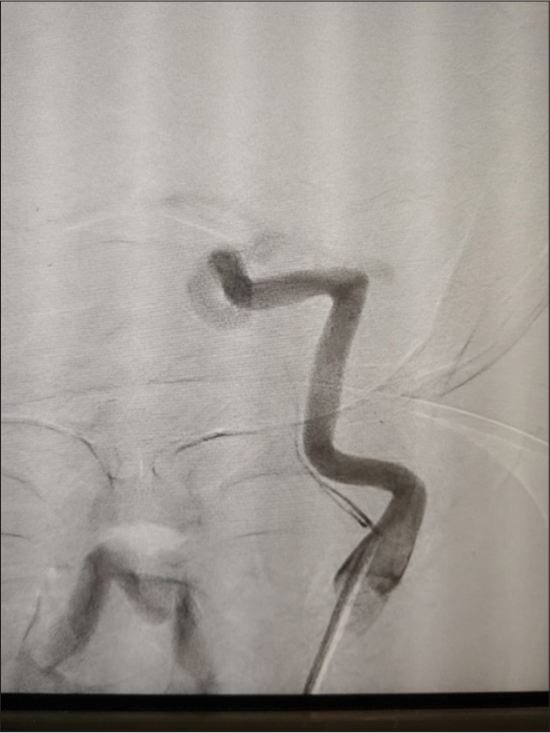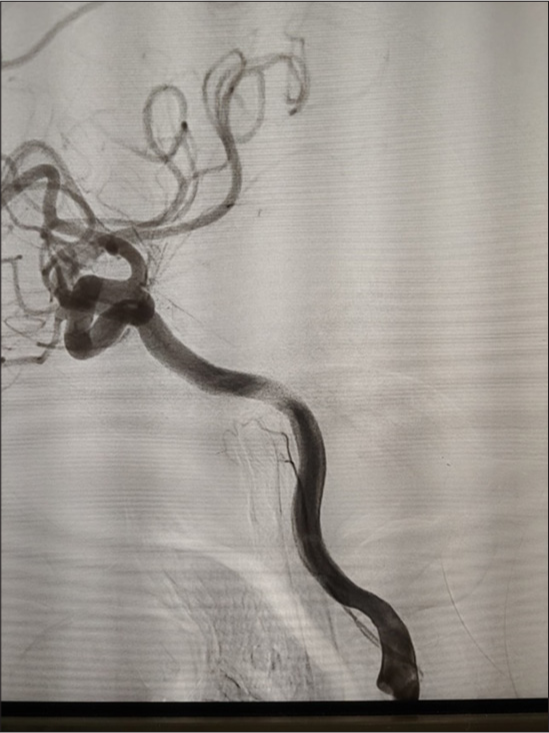Translate this page into:
Origin of ascending pharyngeal artery from cervical internal carotid artery: A case report of rare anatomical variation
*Corresponding author: Sumit Goyal, Department of Neurosurgery and Neurointervention, Yatharth Superspeciality Hospital, Greater Noida, Uttar Pradesh, India. drgoyalsumit@gmail.com
-
Received: ,
Accepted: ,
How to cite this article: Goyal S, Sharma R, Shirodkar AS, Chowdhary V. Origin of ascending pharyngeal artery from cervical internal carotid artery: A case report of rare anatomical variation. J Neurosci Rural Pract. 2025;16:125-7. doi: 10.25259/JNRP_427_2024
Abstract
Typically, the cervical segment of the internal carotid artery does not have any branches in the neck. However, there are many variations reported in the branching pattern of the common carotid artery in the neck with variations in the origin of the named branches of the external carotid artery either from the common or internal carotid artery. Knowledge about these possible variations is important while planning any vascular procedure in the neck. We report one such variation where the ascending pharyngeal artery was originating from the cervical segment of the internal carotid artery discovered in a patient who underwent digital subtraction angiography for stroke.
Keywords
Anatomic variation
Ascending pharyngeal artery
Carotid artery
INTRODUCTION
The internal carotid artery in the neck usually does not have any branch. However, many variations of branching in common carotid and internal and external carotid arteries are described. Understanding and identifying these variations is important for surgeries in the neck and endovascular procedures involving these arteries.
We describe a variation in which we encountered an Ascending Pharyngeal Artery (APhA) originating from the internal carotid artery.
CASE REPORT
A 45-year-old male presented to us with episodes of left hemiparesis and speech difficulty lasting for 15–20 min followed by complete improvement. A clinical diagnosis of left middle cerebral artery (MCA) territory transient ischemic attack (TIA) was made and he was evaluated further.
As part of his evaluation, he was subjected to a cerebral digital subtraction angiogram (DSA). His cerebral DSA did not reveal any abnormality that can be attributed to his TIA-like symptoms. However, the DSA revealed an angiographic variation in the left internal carotid artery.
The APhA was originating from the left cervical internal carotid artery [Figures 1 and 2], which otherwise should not have any branch in the neck.

- Early arterial injection of left internal carotid artery showing origin of ascending pharyngeal artery.

- Left internal carotid artery injection showing filling of ascending pharyngeal artery which is originating from cervical internal carotid artery.
The patient was further managed medically and was discharged on the best medical therapy.
DISCUSSION
Many variations in carotid anatomy are described in the literature, and they include rare findings like the complete absence of a common carotid artery in the neck[1] to the origin of named branches of external carotid artery from internal carotid artery or common carotid artery.[2,3]
APhA originating from an internal carotid artery is the most common variation and is reported in around 2% of cases in autopsy.[4]
Identification of these variations is very important in planning procedures in head-and-neck surgery and endovascular procedures as this is one of the most complex arteries of the neck with extensive supply through its two trunks – pharyngeal and neuromeningeal trunk to structures in the neck and skull base, including cranial nerve supplies. These arteries have extensive anastomosis with internal maxillary arteries, internal carotid artery as well as vertebral artery.[5]
APhA is of importance in many skull base pathologies like the healing of LeFort 1 osteotomies, as it supplies the posterior palatal soft-tissue pedicle. It can be the source of epistaxis where selective embolization can provide control during embolization of tumors of the skull base and nasopharyngeal area, and this artery is of prime importance, and knowledge about the anatomy and potential “dangerous anastomosis” is necessary.[5] The APhA has a direct and indirect connection with the internal carotid artery. Through its superior pharyngeal branch it has anastomosis with the inferolateral trunk of the internal carotid artery, clivial branches may have direct anastomosis with the internal carotid artery or indirectly through the meningohypophyseal trunk. So while embolizing tumors like juvenile nasal angiofibroma stroke of internal carotid artery territory through these anastomosis is a possible complication.[6]
The origin of these anomalies can be explained by the embryological concept of aortic arch differentiation.
In a 12–14 mm, embryo six pairs of aortic arches develop between the dorsal and ventral aorta.
External carotid and maxillary system develop from the first pair while part of the internal carotid and common carotid develops from the third arch. Variants arise when vascular remnants of the first and second arch get attached to the vascular buds of the internal carotid artery instead of the external carotid artery.[7]
The occipital artery is the most common artery originating from the internal carotid artery.[8]
In this case, this was an incidental finding with no implications for treatment. However, the knowledge of these variations is important in surgical planning in the neck as the common way to identify the internal carotid artery in the neck is the absence of any branches from it; however, variations like this may make identification of internal carotid artery tricky or may lead to complications.
CONCLUSION
Knowledge about the variations in branching pattern of external carotid is important for carrying out surgeries or intervention in neck and skull base to aviod complications during these vascular procedures. Ascending pharyngeal artery is an important artery for supply to neck and skull base with important cranial anastomosis, the knowledge of which is important for safe intervention.
Ethical approval
The Institutional Review Board approval is not required.
Declaration of patient consent
The authors certify that they have obtained all appropriate patient consent.
Conflicts of interest
There are no conflicts of interest.
Use of artificial intelligence (AI)-assisted technology for manuscript preparation:
The authors confirm that there was no use of artificial intelligence (AI)-assisted technology for assisting in the writing or editing of the manuscript and no images were manipulated using AI.
Financial support and sponsorship: Nil.
References
- Republished: A rare case of absent left common carotid artery with bovine origin of the left external carotid artery. J NeuroInterv Surg. 2017;9:e20.
- [CrossRef] [PubMed] [Google Scholar]
- Anomalous ascending pharyngeal artery arising from the internal carotid artery: Report of three cases. Ann Vasc Surg. 2013;27:240.e1-4.
- [CrossRef] [PubMed] [Google Scholar]
- Origin of thyrolingual trunk from the common carotid artery. J Neurosci Rural Pract. 2018;9:642-3.
- [CrossRef] [PubMed] [Google Scholar]
- Anomalous branches of the cervical internal carotid artery: Two cases of clinical importance. J Vasc Surg. 1988;8:634-7.
- [CrossRef] [PubMed] [Google Scholar]
- Dangerous extracranial-intracranial anastomoses and supply to the cranial nerves: Vessels the neurointerventionalist needs to know. Am J Neuroradiol. 2009;30:1459-68.
- [CrossRef] [PubMed] [Google Scholar]
- The ascending pharyngeal artery: Branches, anastomoses, and clinical significance. AJNR Am J Neuroradiol. 2002;23:1246-56.
- [Google Scholar]
- Aortic development and anomalies. Semin Intervent Radiol. 2007;24:141-52.
- [CrossRef] [PubMed] [Google Scholar]
- Anatomical variant: Ascending pharyngeal artery arising from the extracranial internal carotid artery. Indian J Vasc Endovasc Surg. 2017;4:127-8.
- [CrossRef] [Google Scholar]






